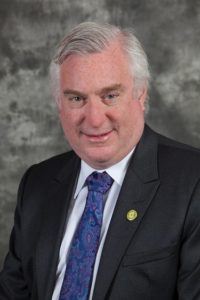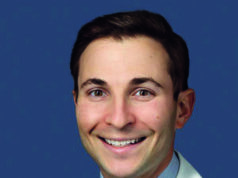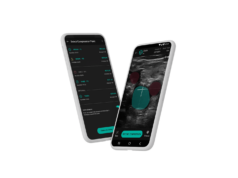
Operating in the shadow of New York City, Clifford M. Sales, MD, has had his finger on the pulse of North America’s two worst-affected regions since the scourge of COVID-19 first started to take hold locally.
New York’s pandemic plight initially captured much of the national headlines. But for Sales, across the Hudson River in the nearby environs of northern New Jersey, the narrative of the second hardest-hit hotspot was developing.
Yet, as Sales reflects on a calamity the state could not see coming, he describes an arrival that landed suddenly—both literally and figuratively.
“It crept up on us pretty quickly,” recalls the managing partner of the Cardiovascular Care Group and chief of vascular surgery at Overlook Medical Center in Summit, New Jersey. “We watched what was happening in New York, and we were certainly getting ready. Once it started, the best way to way to describe it was as if we were standing on the beach and watching a tidal wave approach, hoping it broke before it got to us. And then, in a second, it was over on top of us, swallowing us. That would be the best analogy I could give as to what happened.
“As best we could, we prepared,” continues Sales, also clinical assistant professor of surgery at the Icahn School of Medicine at Mount Sinai across in New York. “From an infrastructure point of view, we were relatively prepared. A lot of the TV news was overblown—the ventilators, the space issues were all real but we handled it as one would expect.
“Yes, we had to make space. We had to use places that we did not use before for patient care. We had to stop doing elective surgery so we could use recovery rooms and so we did not create more foot traffic. We designated special wards that would open in sequence as the need arose—and that is exactly what happened. People collaborated and simply stepped up and did their job and whatever was asked of them.
What perhaps no one was prepared for, Sales says, was the human price—on patients, their families and the medical professionals tending to their care. On a personal level, the role he played as a vascular surgeon brought with it a heavy emotional burden.
“I don’t just mean the death toll,” he explains. “When we first started out, we recognized that those patients with comorbidities (diabetes, hypertension or obesity) of those that were older were at greater risk.
“But what we didn’t expect was a whole cadre of 30- and 40-year-old healthy patients dying in front of us. We were not ready to deal with the fact banning all visitors from the hospitals would be so difficult for the families, the patients and, quite frankly, the medical and nursing staffs. The poor families sitting at home not being able to see their loved ones, knowing they were dying; having to talk to a family over the phone about taking someone off life support because there is no chance of them making it. It is hard enough to do face to face … it was just awful. I don’t think we’re over that yet to be quite honest with you.”
There is also a family dimension on the doctor’s side of the equation. Sales illustrates the point: “When you as a doctor and a parent enter a room, fully gowned, to place a catheter in a patient whose deadly disease is known to be contagious, it adds a level of stress we have not witnessed since the beginning of the AIDS crisis in the 1980s—and you have children.
“For us as vascular surgeons, the COVID pandemic has not been physically difficult. We have had to put in a catheter for dialysis, for medicines, for monitoring—that’s been pretty routine for us. We really have not done much surgery. But the mental anguish has been exceedingly difficult.”
On a more granular level, the vascular role has varied across the seven hospitals in which Sales and his team operate.
“We’re really not involved in managing the patients,” he explains. “That’s been the job of the critical care doctors who have done a phenomenal job. What they needed from our 15-person vascular surgery group was to be technicians—get catheters in—so they could treat the patients the way they needed to be cared for. Our goal was to facilitate the care these doctors were providing. If they needed something, we just did it: Don’t ask questions, just do it. Give them what they need and get out of their way.”
Further down the line, as the pandemic played out and specific vascular complications began to rear their head, his specialists grew more involved. “For example, being very, very liberal in the use of anticoagulation,” Sales says. “There seems to be some type of pro-thrombotic phase associated with the cytokine release stimulated by the virus. In the news this week, we heard about a Broadway star out in California who lost his leg from COVID. We’re seeing that all too frequently and our ability to intervene has been limited.”
Venous complications are common. “We are seeing venous thrombosis,” says Sales. “The catheters we’re putting in are clotting. Patients are developing or presenting with deep vein thrombosis and/or pulmonary emboli. We have, on several occasions, used systemic TPA for pulmonary emboli with significant right heart strain.”
Away from the COVID-afflicted population, meanwhile, another wave of patients is emerging. “We’re starting to see the patients who have vascular disease and who were staying away from the medical field because they were just petrified of COVID-19,” says Sales.
“They didn’t want to go to a doctor, they didn’t want to go to a hospital; they just sat at home trying to ride out the storm. Most of them are older patients with diabetes. They knew they were probably targets for the virus. We are starting to see them; I saw two patients today who have advanced disease, probably more advanced than it was six weeks ago. I think we’re going to see more complicated peripheral vascular reconstructions than we saw before.”












